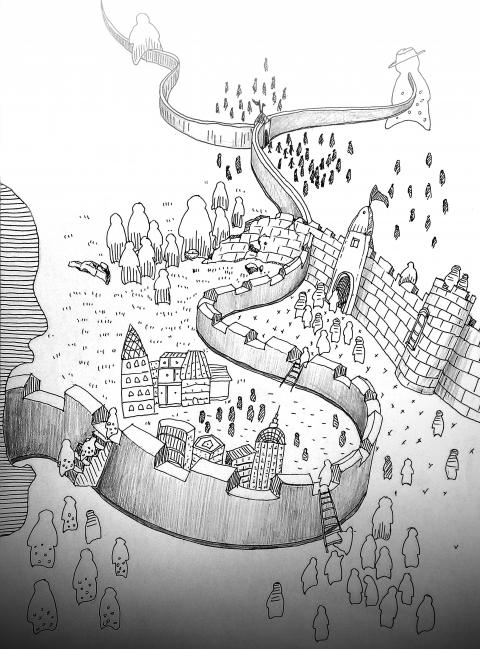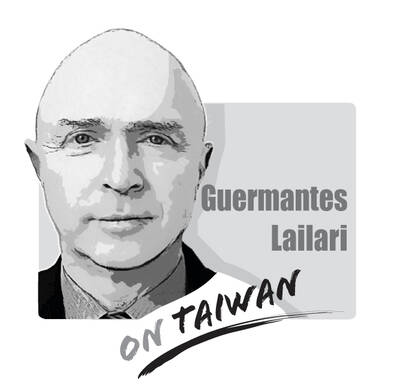“Something there is,” runs a line from Robert Frost’s poem Mending Wall, “that doesn’t love a wall.” However, for as long as mankind has been building, we have been building walls: around cities, along borders, across disputed lands; to protect, keep out, demarcate and divide.
Jericho, on what is now the West Bank, threw up its walls as early as 8000 BC. China built stretches of its Great Wall by 700 BC. Hadrian’s Wall, “to separate the Romans from the Barbarians,” came in AD 129.
In recent times, France misplaced its faith in a supposedly impregnable barrier on its frontier with Germany.

Three decades later, concrete and barbed wire was slicing Germany’s former capital in half as well. The Maginot Line did not work and the Berlin Wall did not last.
However, walls and fences have not stopped going up. Indeed, since the Iron Curtain came down a quarter of a century ago, the world has been busy building separation barriers at a rate perhaps unequaled in history: At least 9,650km of wire, concrete, steel, sand, stone, mesh; anything to keep peoples out — or in.
It is not just walls separating divided communities in cities such as Belfast and Homs, or compounds hermetically sealed to divide rich from poor such as in Sao Paulo.
The vast majority of barriers are going up on borders — and not just around dictatorships or pariah states.
Most strikingly, some of the world’s leading democracies including the US, Israel and India have, in the past decade, built thousands of kilometers of barriers.
Since 2006, the US has erected almost 1,000km of fence along its Mexican border. Israel is building a 640km West Bank barrier, plus another 270km fence along its Egyptian border.
India has built a 550m barrier along the so-called Line of Control of its disputed border with Pakistan, and is busily constructing another 4000km fence on its frontier with Bangladesh.
Last year, Greece threw up a 4m high wall along its short land border with Turkey.
What is odd is that this building is happening at a time when less-physical walls appear to be crumbling. This is the age of the global economy, multinationals, vanishing trade barriers; of “the free movement of goods, capital, services and people,” unprecedented mobility and instantaneous communication.
So why build new walls — especially when, as history shows, the old ones rarely did what they set out to do.
As Janet Napolitano, until recently US secretary of homeland security, once astutely observed: “Show me a 50ft wall, and I’ll show you a 51ft ladder.”
James Anderson, emeritus professor of political geography at Queen’s University Belfast, says that walls get built for very different reasons.
“There are those built as a response to internal civil, often ethno-national, conflict, within states and often within cities. There are those erected because two groups are going at each other, but the state itself is not at stake — rich against poor, white against black, criminal against potential victim. And there are those that run along state borders,” he says.
Justified more often than not, these days, as anti-terrorist measures, border fences are more likely to be aimed “at keeping out, or at least differentiating, migrant labor,” Anderson says.
He distinguishes, too, between walls that came from “the bottom up,” and those imposed from the top down.
Belfast’s walls, he says, originated in 1969 as “defense mechanisms, barricades made of bedsteads and doors to stop vehicles coming in to your street.”
Thirty years on, they have become “part of people’s reality” and are still — perhaps uniquely — supported by almost all those who live beside them. Running for the most part parallel to the roads into the city center, though, they are not “huge impediments” to day-to-day life.
The barrier separating Israel and the West Bank is different.
“This was a state project,” Anderson says. “Certainly some, especially the settler movement, welcome it as protection, security against suicide bombers. Palestinians see it as a mechanism for a land grab.”
At times it also causes almost unimaginable inconvenience and hardship.
However, walls can have unforeseen consequences, says Mick Dumper, professor in Middle East politics at Exeter University.
“Israel built the separation barrier to separate two communities and prevent terrorism,” he says.
“One result has been that 60,000 to 70,000 Palestinians who had moved out of Jerusalem have moved back, as they didn’t want to be cut off from the services they need. At a time when Israel is seeking to assert the city’s Jewish identity, its Palestinian population has sharply increased.”
And a wall changes a city, even after it has come down.
Wendy Pullan, senior lecturer in the history and philosophy of architecture at Cambridge University, calls this a “disruption of urban order. A divided city changes its whole metabolism. And divided cities do not flourish.”
The physical reorganization engendered by a wall is accompanied by an inevitable impact on the psychology of those who live beside it, adds Pullan, who heads the Conflict in Cities (CinC) project run by Cambridge University’s center for urban conflicts research: “There’s a tendency to vilify those on the other side. It’s very easy to say: We can’t see them, we don’t know them, so we don’t like them.”
Mainly, walls just do not do their job very well.
“We don’t have examples of walls solving problems,” Pullan says.
Suicide bombings may have fallen dramatically since Israel built its wall.
“But it’s hard to say whether that’s cause or correlation. The regime has also got much firmer, in other ways,” she adds.
Anderson, also a member of CinC, argues that national border fences are at least partly intended for show: to let governments be seen to be doing something.
If the US were truly serious about tackling illegal migrant labor “it would prosecute more employers,” he says.
So in general, walls are “more symbolic than anything else. However, their symbolism is enormous. Even now, Berlin remains best known for the wall. The most recognisable image of Jerusalem is now, arguably, its wall. The visual impact is so very strong. If you want to get across the idea of division, a wall is very, very powerful,” Pullan says.

There is much evidence that the Chinese Communist Party (CCP) is sending soldiers from the People’s Liberation Army (PLA) to support Russia’s invasion of Ukraine — and is learning lessons for a future war against Taiwan. Until now, the CCP has claimed that they have not sent PLA personnel to support Russian aggression. On 18 April, Ukrainian President Volodymyr Zelinskiy announced that the CCP is supplying war supplies such as gunpowder, artillery, and weapons subcomponents to Russia. When Zelinskiy announced on 9 April that the Ukrainian Army had captured two Chinese nationals fighting with Russians on the front line with details
On a quiet lane in Taipei’s central Daan District (大安), an otherwise unremarkable high-rise is marked by a police guard and a tawdry A4 printout from the Ministry of Foreign Affairs indicating an “embassy area.” Keen observers would see the emblem of the Holy See, one of Taiwan’s 12 so-called “diplomatic allies.” Unlike Taipei’s other embassies and quasi-consulates, no national flag flies there, nor is there a plaque indicating what country’s embassy this is. Visitors hoping to sign a condolence book for the late Pope Francis would instead have to visit the Italian Trade Office, adjacent to Taipei 101. The death of
The Chinese Nationalist Party (KMT), joined by the Taiwan People’s Party (TPP), held a protest on Saturday on Ketagalan Boulevard in Taipei. They were essentially standing for the Chinese Communist Party (CCP), which is anxious about the mass recall campaign against KMT legislators. President William Lai (賴清德) said that if the opposition parties truly wanted to fight dictatorship, they should do so in Tiananmen Square — and at the very least, refrain from groveling to Chinese officials during their visits to China, alluding to meetings between KMT members and Chinese authorities. Now that China has been defined as a foreign hostile force,
On April 19, former president Chen Shui-bian (陳水扁) gave a public speech, his first in about 17 years. During the address at the Ketagalan Institute in Taipei, Chen’s words were vague and his tone was sour. He said that democracy should not be used as an echo chamber for a single politician, that people must be tolerant of other views, that the president should not act as a dictator and that the judiciary should not get involved in politics. He then went on to say that others with different opinions should not be criticized as “XX fellow travelers,” in reference to